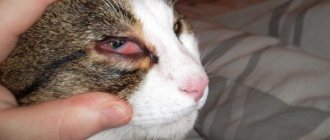Cats, like people, can suffer from various diseases, be injured or have pathologies. The animal cannot help itself, so it is important for the owner to be fully prepared and be able to help the pet in various situations. This must be done carefully, because an animal that is injured or suffering from painful sensations can become aggressive and cocky, because it does not know that they want to alleviate its condition, but it feels the additional discomfort very well.
Let's look at cases of bleeding in cats from the urethra (hematuria) and from the uterus, why they happen, and what needs to be done.
Negative reasons for discharge
The causes of intrauterine bleeding in cats can be different.:
- Inflammatory diseases, including endometritis, pyometra. The reproductive system of a pet includes the ovaries, uterus, vagina and external genitalia. They are manifested by the animal’s restlessness, the appearance of aggressiveness, and active licking of the external genitalia;
- Damage to the uterus. Accompanied by copious bleeding. There are many blood vessels on the walls of this organ;
- Oncological diseases of cats. Cancer cells suppress the general immune system, including the genitourinary system. Danger is indicated by purulent bloody discharge with an unpleasant odor. They are caused by the growth or destruction of a tumor;
- Decaying placenta. It is possible that after birth, part of the placenta will remain inside. This leads to its decomposition. As a result, blood comes from the vagina. There is a high probability of surgical intervention.
© shutterstock
Bleeding due to vaginitis
The disease is an inflammatory process in the vaginal area. A female with a similar pathology attracts males. Therefore, many owners confuse vaginitis with estrus. In cats, bleeding with this disease is accompanied by frequent licking of the perineum and restlessness. If you suspect this disease, you should show the animal to a specialist as soon as possible.
A complication of vaginitis can be an inflammatory process in the bladder, pyometra and pathology of the inner layer of the uterus.
Pyometra
A disease of cats that occurs when the level of progesterone in the blood increases. Leads to purulent inflammation of the uterus. Cats that have never given birth and are receiving antisex drugs to suppress estrus are susceptible.
The disease can be open or closed, depending on the open/closed cervix. The open version is characterized by purulent or bloody discharge. It is easier for the cat to tolerate due to the fact that the discharge comes out through an open lumen in the cervix. With the closed version there is no discharge. Pus and blood accumulate in the uterus. And since at an early stage, closed pyometra is asymptomatic, this will lead to intoxication, rupture of the organ and death of the cat.
Symptoms of the disease:
- deterioration of general condition;
- lack of appetite, vomiting;
- increase in abdominal volume;
- active licking of the belly.
In most cases, removal of the cat's uterus and ovaries is an effective treatment. After surgery, a course of antibiotic treatment is carried out, as well as maintenance therapy. In some cases, drug therapy is allowed. However, it is worth considering that it can lead to temporary improvement with further relapse.
What you can encounter and what the owner should be afraid of
To begin with, urine is the fluid that is excreted from the body as a result of the work of the kidneys, ureter and bladder. Along with it, various toxins, micro- and macroelements go away. Normally, it should be transparent or light yellow.
Diuresis in a healthy pet is 1-2 ml/kg/h. A minimum of 1 ml should be released.
For example, a pet weighs 4 kg, let’s calculate (1 ml x 4 kg x 24 hours = 96 ml), therefore, it should release approximately 96 ml per day.
Endometritis
Inflammation of the uterine mucosa. The cause is genital infections. Animals walking on the street, young cats under 3 years of age, when using hormonal drugs for estrus, an unbalanced diet, difficult childbirth, and a hereditary tendency are at risk.
© shutterstock
The disease is considered in acute or acquired form. Let's look at the symptoms. In the acquired form, symptoms are mild. The pet looks healthy in appearance, but often licks itself, so the cat’s blood from the uterus is not visible. The danger is that this form can become purulent. This is due to increased accumulation of secretions due to thickening of the uterine mucosa. The secretion is a favorable environment for the development of infections. Characterized by copious discharge and increased body temperature. Urgent medical assistance is required.
Symptoms in acute form:
- temperature increase;
- loss of appetite;
- copious discharge from the genital opening;
- often arches his back and assumes a posture for urination;
- abdominal enlargement;
- the external genitalia are inflamed.
At an early stage, antibiotics and antimicrobials are used. In case of purulent form, sterilization is carried out. To increase the body's defenses, immunomodulators are prescribed.
What to do?
If bloody discharge that is not associated with physiological factors is detected, it is recommended to immediately consult a veterinarian. He will carry out diagnostic procedures:
- history taking and external examination;
- cytological examination of the contents discharged from the uterus;
- histology of the biological material taken;
- ultrasound diagnostics of abdominal organs, x-ray;
- laboratory tests - blood.
After identifying the cause of bleeding, treatment is prescribed aimed at relieving symptoms and eliminating the cause:
- For inflammation or bacterial infection - antibiotics.
- Endometritis, placental decomposition, tumors – surgery. For oncology – radiation or chemotherapy.
- If a large amount of blood is lost, a transfusion is required.
- Removal of the uterus and ovaries in case of serious, profuse hemorrhages.
- Immunostimulants – Ribotan, Gamavit, Ovariovit.
- Reducing symptoms of intoxication - Ringer's solutions, glucose or rheopolyglucin.
Uterine bleeding is a sign of serious disorders, so the health and life of your pet depends on the timeliness of treatment. When the first signs are detected, it is recommended to immediately contact a veterinarian.
Symptoms of uterine bleeding
What symptoms indicate bleeding? With hidden bleeding, the cat becomes lethargic, inactive, and has an impaired appetite. Severe shortness of breath and increased fatigue appear. The temperature on the skin of the paws is significantly lower than the body. The abdomen is dense, enlarged, the mucous membranes are pale. Symptoms increase gradually over a period of several days to several weeks.
The owner should not forget that during intrauterine bleeding, almost all the blood remains in the organ cavity. And only in isolated cases are spots on the external genitalia. Such bleeding is very dangerous because it is detected too late.
If there is obvious bleeding, the cat coughs up blood, vomits, and the stool becomes liquid with bloody streaks. Bloody discharge from the loop and blood in the urine are observed. It is important to immediately consult a doctor if the symptoms listed above are present, as well as if the bleeding continues for more than 15 minutes and the cat has significant blood loss after it stops.
© shutterstock
First aid when a cat is bleeding from the vagina prohibits any independent actions.
Normal changes that occur in the body
In some cases, bloody discharge is observed in a cat for reasons related to natural processes. Such circumstances do not pose a threat to the health of the animal. Such changes include the following:
- Estrus. This process is accompanied by an increase in the pet’s activity. The female often arches her back, rolls around on the floor, and becomes playful. It is absolutely normal for a cat to have bloody discharge during estrus. After this period ends (as a rule, this happens after a few days), the symptom disappears completely.
- Bearing offspring. The presence of this sign in a pregnant female indicates a restructuring of the body and preparation for the birth of cubs. However, intense discharge indicates the development of serious pathological processes.
A cat has white uterine discharge: normal or pathological?
White genital discharge, if it is not associated with pregnancy or labor, is pus. Most often they occur due to decreased immunity as a result of the use of hormonal contraceptives or hormonal anti-inflammatory drugs.
Staphylococci are activated, which constantly live in the body and do not cause harm to health with a normally functioning immune system. Vaginitis develops.
Another cause of the disease is the consequences of mating with a cat infected with chlamydia, toxoplasma, feline immunodeficiency virus, and mycoplasma.
After a difficult birth, fragments of the placenta remain in the uterus, they fester, leading to endometritis. The most dangerous pathology that begins with white discharge is pyometra. The discharge becomes colored or stops. If additional symptoms appear - depression, pain in the enlarged abdomen, it means that pyometra has passed into the most dangerous - closed form. The pus does not come out, but accumulates inside the uterus.
In older animals, suppuration may be a symptom of a tumor process. The main reason for the occurrence of neoplasms is repeated hormonal disruptions caused by the termination of an unwanted pregnancy or the use of drugs to disrupt estrus.
First, a false pregnancy develops. The animal gets worried, begins to prepare the nest, and spoils the situation. She produces milk, but no kittens. Repeated imaginary tightness is dangerous because it triggers the process of development of neoplasms.
Be sure to read:
What to do if your cat’s ears are red, itchy or spots appear: causes of the disease
Mr. Cat explains: 5 rules for collecting urine
This is the main thing you need to know when collecting urine so that the analysis is most accurate:
- Prepare a cat litter box for collection. Initially disinfect and wash.
- Do not fill it with fillers.
- If the cat refuses to go to an empty tray, you can buy special mixtures in stores that are similar to fillers for collecting tests.
- After the animal has done its business, you need to pour the contents of the tray into a special container for collecting samples.
- Be sure to submit for analysis within 2-3 hours.
Hematuria in a pregnant cat
Finding blood in the urine of a pregnant cat is a common problem; the presence of red blood cells may be normal, but it is better to consult a specialist. Sometimes the appearance of blood may indicate the development of diseases such as cystitis or pyelonephritis. Damage to the kidney, bladder or its walls from stones in these organs is possible.
Hematuria can be caused by dysfunction of the bladder due to the uterus pressing on it, this is partly associated with hormonal changes. In this case, the fetus will not be harmed.
Read more about this here.
First aid
If the owner notices this symptom in his pet, it is necessary to immediately contact a veterinary clinic.
If it is not possible to contact a specialist immediately, you should provide first aid yourself.
- Firstly, ensure complete rest for the animal; you should not let it go outside, or allow it to lie on a cold floor or in a windy place/room. The animal needs peace, warmth, silence and rest.
- Secondly, if the cat has severe pain, then you can inject No-shpa or Analgin with Diphenhydramine intramuscularly. The main thing is to calculate the dosage correctly, since if the dose is too large, it can lead to serious problems.
- Thirdly, in this state, the pet should eat only liquid or semi-liquid food; solid and dry food should be excluded from the diet.
Treatment and prevention
The course of therapy is prescribed by the doctor after a complete examination of the animal. Treatment may include:
- drip and intravenous injections;
- taking antibiotics in the form of intramuscular injections or tablets;
- diet and specialized nutrition;
- substances to normalize coagulation;
- painkillers and antispasmodics;
- installing a catheter if the animal cannot go to the toilet on its own;
- surgical intervention.
To prevent the development of stones in the genitourinary organs, diseases of the kidneys and urinary system, you need to monitor your pet’s diet, perform prescribed vaccinations, prevent worms and fleas, give fermented milk products, provide open access to water, and play with your pet.
Castrated cats should exclude saltwater fish from their diet, as such animals should avoid eating salt.
1111











